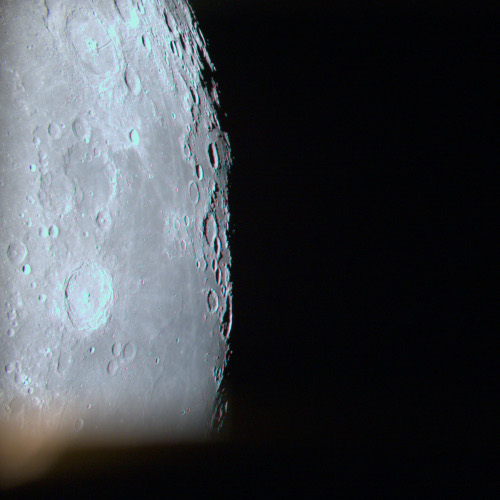Hakuto-R1 snaps first picture of Moon from lunar orbit
The science team for Ispace’s Hakuto-R1 privately-built lunar orbiter/lander earlier this week released the spacecraft’s first picture of the Moon since entering lunar orbit on March 20, 2023.
That image is to the right, cropped and reduced to post here. The photo resolution is quite good. It also demonstrates that the spacecraft’s attitude control systems for pointing the camera are working correctly.
Launched on December 11, 2022 by a Falcon 9 rocket, Hakuto-R1 will land in Atlas Crater on the northeast quadrant of the Moon’s visible hemisphere sometime in April, making it the first successful private commercial planetary lander to reach another world. If successful, it will then release the United Arab Emirates Rashid rover, that nation’s first planetary lander but its second planetary mission, following the Mars orbiter, Al-Amal, now circling Mars.
On Christmas Eve 1968 three Americans became the first humans to visit another world. What they did to celebrate was unexpected and profound, and will be remembered throughout all human history. Genesis: the Story of Apollo 8, Robert Zimmerman's classic history of humanity's first journey to another world, tells that story, and it is now available as both an ebook and an audiobook, both with a foreword by Valerie Anders and a new introduction by Robert Zimmerman.
The ebook is available everywhere for $5.99 (before discount) at amazon, or direct from my ebook publisher, ebookit. If you buy it from ebookit you don't support the big tech companies and the author gets a bigger cut much sooner.
The audiobook is also available at all these vendors, and is also free with a 30-day trial membership to Audible.
"Not simply about one mission, [Genesis] is also the history of America's quest for the moon... Zimmerman has done a masterful job of tying disparate events together into a solid account of one of America's greatest human triumphs."--San Antonio Express-News
The science team for Ispace’s Hakuto-R1 privately-built lunar orbiter/lander earlier this week released the spacecraft’s first picture of the Moon since entering lunar orbit on March 20, 2023.
That image is to the right, cropped and reduced to post here. The photo resolution is quite good. It also demonstrates that the spacecraft’s attitude control systems for pointing the camera are working correctly.
Launched on December 11, 2022 by a Falcon 9 rocket, Hakuto-R1 will land in Atlas Crater on the northeast quadrant of the Moon’s visible hemisphere sometime in April, making it the first successful private commercial planetary lander to reach another world. If successful, it will then release the United Arab Emirates Rashid rover, that nation’s first planetary lander but its second planetary mission, following the Mars orbiter, Al-Amal, now circling Mars.
On Christmas Eve 1968 three Americans became the first humans to visit another world. What they did to celebrate was unexpected and profound, and will be remembered throughout all human history. Genesis: the Story of Apollo 8, Robert Zimmerman's classic history of humanity's first journey to another world, tells that story, and it is now available as both an ebook and an audiobook, both with a foreword by Valerie Anders and a new introduction by Robert Zimmerman.
The ebook is available everywhere for $5.99 (before discount) at amazon, or direct from my ebook publisher, ebookit. If you buy it from ebookit you don't support the big tech companies and the author gets a bigger cut much sooner.
The audiobook is also available at all these vendors, and is also free with a 30-day trial membership to Audible.
"Not simply about one mission, [Genesis] is also the history of America's quest for the moon... Zimmerman has done a masterful job of tying disparate events together into a solid account of one of America's greatest human triumphs."--San Antonio Express-News



Looks like the UAE is quietly building a space program. A Mars orbiter that looks to be doing good science, and now a Lunar rover. They are establishing a presence in two of the most important locations in the Inner System.
Is the blue in the image an artifact of the processing?
Andi: That blue must be an artifact of processing, because it certainly isn’t a feature of the lunar surface.
Figured so, but there’s so much I don’t know about the lunar surface that I thought it would be prudent to ask.
Andi: There is another possibility. I have assumed the image is purely optical in wavelengths, which might be mistaken. There is a chance, though not likely, that this blue color comes from another sensor looking at the moon in non-optical wavelengths, with that data superimposed in false color on top of the optical image. For example, the blue seems to favor the sun-facing slopes of craters, suggesting higher temperatures.
The reason I doubt this is that if it were so, I would have expected the Hakuto-R1 team to have said so. They did not.
I think the blue is being keyed on saturated pixels. Very common in digital processing.